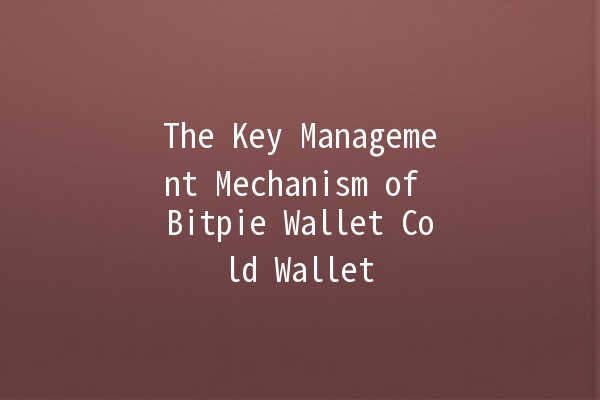
*
Digital wallets have revolutionized the way we manage cryptocurrencies. Among the numerous options available, Bitpie Wallet has emerged as a significant player in the market, especially due to its cold wallet feature. Cold wallets, in contrast to hot wallets, provide enhanced security for holding private keys, which is a crucial aspect for cryptocurrency investors. This article delves into the private key management mechanism of Bitpie Wallet's cold wallet, providing useful insights on maximizing security and usability.
Understanding Cold Wallets
Cold wallets refer to cryptocurrency storage solutions that are not connected to the internet, making them less vulnerable to hacking and online theft. Bitpie Wallet, with its cold wallet functionality, allows users to securely store private keys offline. This section explores the importance of cold wallets and how Bitpie’s implementation stands out.
The Importance of Cold Wallets

The Private Key Management Mechanism
What are Private Keys?
Private keys are cryptographic keys that allow users to access and manage their cryptocurrencies. Understanding how Bitpie Wallet manages these keys is essential for any user looking to enhance their security posture.
Key Generation
When setting up a Bitpie Wallet, the private keys are generated on the user’s device using secure algorithms. This process ensures that the keys are unique and are never transmitted over the internet. Here’s how it works:
Secure Randomness: Bitpie utilizes secure random number generation to create private keys.
UserControlled Generation: Users have the ability to generate keys on their devices, ensuring that no third party can access them.
Seed Phrases: During setup, users are prompted to create a seed phrase. This 12 to 24word phrase is critical for recovering wallets and should be stored securely offline.
Secure Storage
Once generated, while Bitpie Wallet allows users to see their private keys for individual cryptocurrencies, they are stored securely within the app itself. Key storage follows stringent protocols:
Pro Tip: Always have a secure backup of your seed phrase in a location separate from your device to prevent total loss of access to your wallet.
Transaction Signing
When a user initiates a transaction, the private key is used to sign it (confirming ownership) without revealing the actual key to the network. This is a critical feature of Bitpie Wallet's design:
Offline Signing: Transactions can be signed offline, protecting private keys from exposure on potentially compromised devices.
Broadcasting Transactions: After signing, the user can broadcast the signed transaction via an internetconnected device, keeping the private key safe.
Practical Tips to Enhance Productivity with Bitpie Wallet
Here are some key productivity tips for users working with the Bitpie Wallet cold wallet private key management mechanism:
Keeping your wallet software updated ensures that you benefit from the latest security features and patches. Check for updates regularly and install them promptly.
Example: Set a bimonthly reminder to check for updates or read news related to Bitpie Wallet.
When accessing exchanges or any thirdparty service linked to your Bitpie Wallet, ensure you enable multifactor authentication (MFA). This adds an additional layer of security to your transactions.
Example: Use mobile authentication apps like Google Authenticator for MFA setups.
For an added layer of security, consider investing in a hardware wallet that supports Bitpie Wallet transactions, allowing you to store private keys in a physical device away from the internet.
Example: Devices like Trezor or Ledger Nano can be used alongside Bitpie Wallet to manage private keys.
Stay informed about the latest practices in cryptocurrency security. Being knowledgeable will enable you to recognize potential threats and countermeasures effectively.
Example: Follow credible blogs and take part in online exchanges to learn about digital wallet security.
Develop a standardized method for backing up your wallet and keep your backup copies in multiple secure locations.
Example*: Use both physical backups (like writing the seed phrase down) and digital backups (like storing encrypted backups on external drives).
Frequently Asked Questions (FAQs)
Losing your seed phrase means you could potentially lose access to your wallet permanently. Always store it in a secure location. If lost, there is no way to recover your wallet.
Back up your wallet every time you make significant changes, such as adding new cryptocurrencies or performing transactions. Maintain regular backups to ensure data integrity.
You can install Bitpie Wallet on multiple devices, but ensure that your seed phrase and private keys are kept secure. It’s recommended to only use the wallet on trusted devices.
If you lose access to your device, use the recovery option provided during wallet setup utilizing your seed phrase to restore access.
Cold wallets are offline storage solutions, making them more secure from internet threats, while hot wallets are online and easier for frequent transactions but more vulnerable to hacking.
Bitpie Wallet does not impose specific transaction limits; however, network fees may apply dependent on the currency and the transaction size.
al Thoughts
By understanding the private key management mechanism of the Bitpie Wallet cold wallet, users can take proactive steps to enhance their cryptocurrency security. Following best practices for storage, regular updates, and diligent backup operations reinforces the core tenets of secure digital asset management. As the landscape of cryptocurrency continues to evolve, ensuring robust security measures will be paramount for all users. 🔒
Remember, the security of your assets is ultimately in your hands, so take the necessary steps to protect them today!

